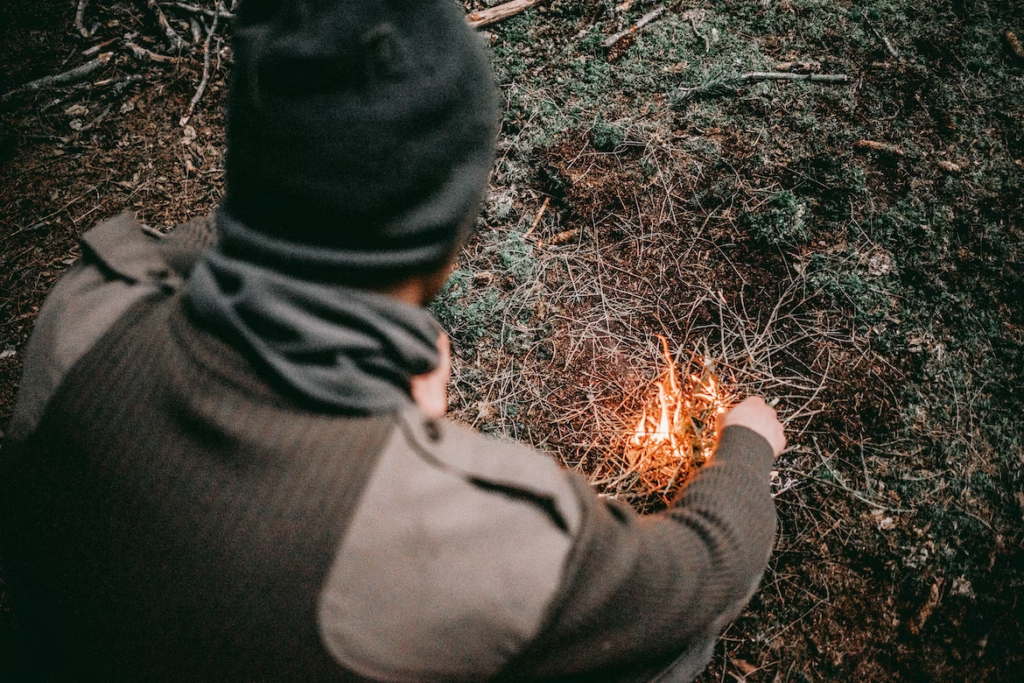Photo by: Tuğba Akdağ Source: Pexels
Fire has been an essential companion to humanity since time immemorial, providing warmth, protection, and a means to cook food. Before the invention of matches and lighters, our ancestors relied on primitive methods to ignite the precious flame. This article delves into several ancient fire-starting techniques, examining their intricacies and providing a comprehensive guide on executing each.
1. Hand Drill Method
This technique is believed to be one of the oldest and simplest ways to produce fire.
Materials Needed:
- Spindle: This should be a straight, dry, dead stick. Softwoods like cedar, yucca, or willow are best for beginners.
- Fireboard: A flat piece of wood. You’ll need to carve a slight depression into it where the spindle will sit.
Procedure:
- Preparation: Position the spindle tip into the depression on the fireboard. Ensure your hands are free of sweat or moisture.
- Generating Friction: Place your hands at the top of the spindle, applying gentle downward pressure. Rub the spindle between your hands, moving them quickly down the length of the spindle. This spinning action generates the needed friction.
- Creating an Ember: As the spindle and fireboard heat up, fine wood particles, called “punk,” will gather in the depression and begin to smolder. This is the ember you’ll use to ignite your tinder.
- Ignition: Once a substantial ember is created, transfer it carefully to a prepared tinder nest (made of dry grass, leaves, or thin bark shavings). Blow gently at the ember within the tinder until it catches fire.
2. Bow Drill Method
This method, a more sophisticated variant of the hand drill, uses a bow to turn the spindle, creating a consistent and efficient source of friction.
Materials Needed:
- Bow: A curved branch with a cordage (string or thin rope) tied to both ends.
- Spindle: As with the hand drill.
- Fireboard: Similar to the hand drill but includes a V-shaped notch carved to catch the ember.
- Socket or Bearing Block: This can be a flat stone, bone, or another piece of wood. It’s used to apply pressure on the spindle from above.
Procedure:
- Setting up the Apparatus: Loop the cord of the bow around the spindle once. This allows you to control the spindle’s movement with the bow.
- Creating Friction: Hold the bow with one hand and use the socket to apply downward pressure on the spindle. Saw the bow back and forth, causing the spindle to rotate rapidly.
- Collecting the Ember: As the spindle rotates, it’ll produce punk in the fireboard’s notch. This will eventually become an ember.
- Ignition: Just as with the hand drill, transfer the ember to your tinder nest and blow gently to produce flames.
3. Fire Plough Method
This technique involves scraping wood to produce fine particles that can be ignited.
Materials Needed:
- Plough: A harder, flat piece of wood.
- Trench: A softer wooden surface with a groove carved into it.
Procedure:
- Creating Wood Shavings: Run the edge of your plough along the trench in the softer wood. The friction will create wood shavings.
- Generating Heat: As you continue to run the plough through the groove, the friction will generate heat, causing the wood shavings to smolder.
- Ignition: Once you’ve created a decent ember, transfer it to a tinder nest and blow gently until it ignites.
Conclusion
Mastering these primitive fire-starting methods requires patience, practice, and a good understanding of the materials you’re working with. While they might not replace our modern tools, learning these techniques can be a rewarding experience, providing a deeper connection to nature and a genuine appreciation for the skills of our ancestors.

